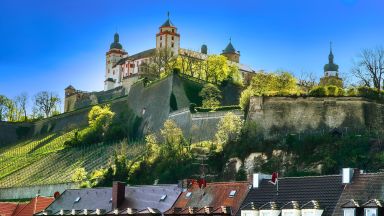Augsburg: The Complete Guide
Augsburg is a city in the state of Bavaria in southern Germany, located about 80 km west of Munich. It is the third oldest city in Germany, with a history that dates back over 2,000 years.
One of the city’s main attractions is its well-preserved Old Town, which features a number of historic buildings and landmarks, including the 16th-century Town Hall, the Renaissance-style Augsburg Cathedral, and the Fuggerei, which is the world’s oldest social housing project.
Augsburg is also known for its association with the Fugger family, who were prominent merchants and bankers during the Renaissance period. The Fugger family’s wealth and influence helped to establish Augsburg as a center of culture and commerce during the 16th century.
In addition to its rich history, Augsburg is also a modern and vibrant city with a thriving arts and culture scene. The city is home to a number of museums and galleries, including the Augsburg Art Museum and the Fugger and Welser Museum, which showcases the history of the city’s prominent merchant families.
Augsburg is also known for its culinary traditions, with a variety of local dishes that reflect the city’s Bavarian heritage. Some popular local dishes include the Augsburger Zwetschgendatschi (a plum tart), the Augsburger Leberknödelsuppe (a liver dumpling soup), and the Augsburger Weißwurst (a veal sausage).
Overall, Augsburg is a charming and historic city with a rich cultural heritage and plenty to offer visitors in terms of history, culture, and cuisine.
Visiting Augsburg for the first time and wondering what are the top places to see in the city? In this complete guide, I share the best things to do in Augsburg on the first visit. Top help you plan your trip, I have also included an interactive map and practical tips for visiting!
This website uses affiliate links which earn a small commission at no additional cost to you.
12 Best places to See in Augsburg
This complete guide to Augsburg not only tells you about the very best sights and tourist attractions for first-time visitors to the city but also provide insights into a few of our personal favorite things to do.
This is a practical guide to visiting the best places to see in Augsburg and is filled with tips and info that should answer all your questions!
Augsburger Rathaus

Location: Augsburg Town Hall, Rathausplatz, Augsburg, Germany | Hours: Daily 10am–6pm | Price: Admission 2€ adults, 1€ children 7–14, free for children 6 and under | Distance: 0.20km
Visiting Augsburger Rathaus
Perlachturm

Location: Perlachturm, Rathausplatz, Augsburg, Germany | Hours: Mon-Sun 10:00-18:00 | Distance: 0.20km
Visiting Perlachturm
Augsburg Cathedral

Location: Katedra NMP w Augsburgu, Frauentorstraße, Augsburg, Germany | Hours: 7 a.m. to 6 p.m - visits are not possible during church service | Website | Distance: 0.30km
Visiting Augsburg Cathedral
Maximilian Museum

Location: Maximilianmuseum, Fuggerplatz, Augsburg, Germany | Hours: Tue–Sun 10 a.m.–5 p.m. Mon closed | Price: Adults €7.00 | Website | Distance: 0.30km
Visiting Maximilian Museum
St. Anne's Church

Location: St. Anne's Church, Im Annahof, Augsburg, Germany | Distance: 0.40km
Visiting St. Anne's Church
Fuggerei

Location: Fuggerei, Jakoberstraße, Augsburg, Germany | Hours: Museum: April through September, 8am - 8pm daily October through March, 9am - 6pm daily Christmas Eve closed | Price: Adults €6,50, Children €3,00 | Website | Distance: 0.50km
Visiting Fuggerei
Fuggerhäuser

Location: Fuggerhaus, Maximilianstraße, Augsburg, Germany | Distance: 0.50km
Visiting Fuggerhäuser
Augsburg Arsenal & Roman Camp

Location: Augsburg Arsenal, Zeugplatz, Augsburg, Germany | Hours: Tue–Sun 10 a.m.–5 p.m. Mon closed | Price: Adult €7 | Website | Distance: 0.50km
Visiting Augsburg Arsenal & Roman Camp
Schaezlerpalais

Location: Schaezlerpalais, Maximilianstraße, Augsburg, Germany | Hours: Tues 10am–8pm; Wed–Sun 10am–5pm | Price: Admission 7€ adults, 5.50€ for students, children 9 and under free | Distance: 0.60km
Visiting Schaezlerpalais
St. Ulrich's and St. Afra's Church

Location: Basilica of SS. Ulrich and Afra, Augsburg, Ulrichsplatz, Augsburg, Germany | Hours: Daily 9am–5pm | Price: Free | Distance: 1.00km
Visiting St. Ulrich's and St. Afra's Church
Rotes Tor

Location: Rotes Tor, Am Roten Tor, Augsburg, Germany | Distance: 1.20km
Visiting Rotes Tor
Augsburger Puppenkiste

Location: Augsburger Puppenkiste, Spitalgasse, Augsburg, Germany | Hours: Museum: Wednesday to Sunday 12.00 p.m. to 6.00 p.m. (admission until 5.30 p.m.) | Website | Distance: 1.20km
Visiting Augsburger Puppenkiste

